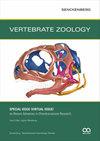限制生存空间:不同繁殖方式粘蛙的发育和幼虫形态
IF 2.3
2区 生物学
Q1 ZOOLOGY
引用次数: 0
摘要
我们比较了三种亲缘关系密切的粘蛙(Kalophrynus Tschudi,1838)的繁殖特征、发育和幼虫形态,它们栖息在越南的低地和山区森林中,并表现出各种繁殖模式。林间K.interleatus在开放的临时池塘中繁殖,而本氏K.honbaensis和隐孔K.cryptophonus是利用树洞和竹茎繁殖的植物繁殖者。它们的蝌蚪在营养特化方面也有所不同:林蛙幼虫是典型的悬浮进食者,而本贝蛙和隐纹蛙则是专性卵食性的。这三个物种的卵和窝的大小、胚胎期和孵化期的持续时间以及幼虫消化道和骨骼的结构都不同。根据外部和内部形态,我们得出结论,林蛙和隐蛙的蝌蚪代表了微型幼虫适应谱的两个“极端”,而本贝蛙则表现出一系列短暂特征。基于无核生物学的这些新发现,我们讨论了从池塘繁殖到植物茎繁殖以及从微食到大食的过渡过程中的生殖、个体发生和形态重排,以及所揭示的对不同栖息地和幼虫生活模式的适应的意义。本文章由计算机程序翻译,如有差异,请以英文原文为准。
Restricting living space: Development and larval morphology in sticky frogs (Microhylidae: Kalophrynus) with different reproductive modes
We compare reproductive features, development, and larval morphology in three closely related species of sticky frogs (Kalophrynus Tschudi, 1838) inhabiting the lowland and mountain forests of Vietnam and displaying a variety of reproductive modes. While K. interlineatus breeds in open temporary ponds, K. honbaensis and K. cryptophonus are phytotelm-breeders using tree hollows and bamboo stems for reproduction. Their tadpoles also differ in trophic specialization: larval K. interlineatus are typical suspension-feeders, whereas K. honbaensis and K. cryptophonus are obligatorily oophagous. All three species differ in egg and clutch sizes, duration of embryonal period and hatching stage, and the structure of the larval digestive tract and skeleton. Based on external and internal morphology, we conclude that tadpoles of K. interlineatus and K. cryptophonus represent two “extremes” of the adaptive spectrum of microhylid larvae, while K. honbaensis displays a set of transitory traits. Relying on these new findings in anuran biology, we discuss reproductive, ontogenetic, and morphological rearrangements during the transition from pond breeding to phytotelm breeding and from microphagy to macrophagy as well as the significance of the revealed adaptations to different habitats and larval life modes.
求助全文
通过发布文献求助,成功后即可免费获取论文全文。
去求助
来源期刊

Vertebrate Zoology
ZOOLOGY-
CiteScore
4.00
自引率
19.00%
发文量
42
审稿时长
>12 weeks
期刊介绍:
Research fields covered by VERTEBRATE ZOOLOGY are taxonomy, morphology, anatomy, phylogeny (molecular and morphology-based), historical biogeography, and palaeontology of vertebrates.
 求助内容:
求助内容: 应助结果提醒方式:
应助结果提醒方式:


